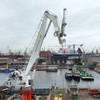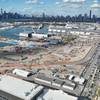Hand-in-hand with the accelerated development in the size of long-haul container vessels must come changes in the structure, design and deployment of the feedership fleet. According to David Tozer, Lloyd's Register's Business Manager for Container Ships, some 1,300 new vessels will be required to accommodate anticipated cargo growth in the feeder trades up to 2012. The calculation is based on projections of a doubling in trade volume in feeder and intra-regional operations during the period 2002-2012.
Moreover, around 600 newbuilds will also be needed to replace existing tonnage over the same timeframe, suggesting a total demand in the order of 1,900 ships. Assumptions regarding fleet renewal stem from an analysis which indicated that up to 40 percent of feederships worldwide were at least 15 years old, suggesting that much of the tonnage involved would be removed from the market by 2010.
For 1,900 or so vessels to be introduced into service by 2012 would necessitate an annual infusion of newbuilds at a rate well in excess of current levels. In the opening edition of Container Ship Focus, a technical publication produced by LR*, David Tozer is reported as taking the view that the lack of efficient, modern feeder tonnage poses a major threat to the container sector, and could potentially compromise the industry's investment in new, large post-panamax capacity.
"There is a clear need for modern feeder designs which are flexible yet targeted, but so far there is little evidence that this opportunity has been realized, and few orders have been placed," contended Tozer.
LR, in association with Ocean Shipping Consultants, has identified a range of feeder designs, each optimized for a particular trading region. Tozer is of the view that the feeder trades could potentially become one of the most important sectors for the container industry. "But to date there has been a failure to recognize the scale of the future demand. Without proper investment, the lack of capacity could constrain demand and adversely impact on deepsea vessel economics," he claimed.
Recent figures have indicated that around half of all newbuild boxship capacity on order or under construction entails vessels of more than 6,000-TEU. For sure, the overall containership orderbook does have the appearance of being out of balance, with its capacity orientation to a large number of very large vessels. Investment in smaller boxships and feeders has been at a markedly lower level, to the extent that a serious demand scenario has developed at the lower end of the size spectrum.
Featured videos

AI to the Rescue: Zelim’s ZOE to be Installed on Cruise Ship

Xenos Marine Takes Aim at the Gulf Salvage, Decommissioning Markets
April 2025
 Read the Magazine
Read the Magazine

 Read the Magazine
Read the Magazine
This issue sponsored by:

Saltchuk Doubles Down on Workforce Development Investments
Subscribe for
Maritime Reporter E-News
Maritime Reporter E-News is the maritime industry's largest circulation and most authoritative ENews Service, delivered to your Email five times per week









